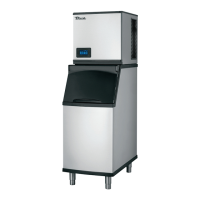TRUE ICE SERVICE MANUAL truemfg.com
TEC_TM_198 | REV. A | EN
P#857284
03/26/2024 Page 12 of 96
Good Refrigeration Practices
Good Refrigeration Practices
• Before opening the refrigeration system remember that the
POE oil is very hygroscopic and absorbs moisture very quickly.
You should not leave the system open to the atmosphere for
more than 15 minutes. Any vacuum that exists before any
repair should be broken with nitrogen
to avoid moisture being pulled into the system.
• When accessing the system do not remove process
tube ends. Use Temporary bolt on access valves for
diagnosing and repair.
• When repair is complete valves need to be removed.
• For your manifold gauges, use as short as hose as possible.
We recommend a maximum length of 12”.
• The introduction to the refrigeration system of anything other
than a flushing agent, nitrogen, refrigerant, or oil
is prohibited.
• If you are changing a component keep the system closed up
with plugs or caps to reduce moisture contamination.
• Recover the refrigerant from the system. Note R-290
can be vented in a well ventilated area with no source
of ignition.
• Remove the faulty refrigeration component and filter drier by
cutting them out with a tubing cutter.
• Take a look at the filter drier and the components that have
been removed for signs of oil breakdown, foreign objects like
desiccant from drier, metal pieces from valves, etc.
• Be sure and test the oil from the refrigeration system for
contamination using the proper test kit for the type of oil.
• When replacing a compressor make sure to also remove all
the old oil from the system.
• If the oil shows signs of contamination. Flush the system.
• While purging nitrogen through the system drill
(approximately 1/8”) (3.18 mm) hole in the bottom of the
accumulator (IF EQUIPPED) so we do not leave contaminated
oil in the system. After blowing this out with nitrogen, be
sure to braze the hole closed.
• Always replace the drier with the exact OEM size.
• When brazing on R-290 system always purge nitrogen
through the system.
• Place a nitrogen charge in the system to check for
any leaks.
• Release the nitrogen down to 2 PSI.
• Change vacuum pump oil regularly to ensure the deepest
vacuum your pump is capable of.
• Start pulling a vacuum as soon as possible to help
remove moisture.
• Using a micron gauge pull down to 500 microns.
• See if the system will hold this micron with the gauges closed
and the pump switched off to test for leaks
of moisture.
• Once the system is evacuated, weigh in the listed refrigerant
charge located on the serial tag inside the cabinet. R-290 can
be added as a liquid or vapor. Refrigerant 134a/404A charge
as a liquid only.
Refrigerant should be charged through the high side.
• Test run unit and check for proper operation.
• Remove access valves.
ANY NITROGEN ADDED TO THE SYSTEM SHOULD NOT
EXCEED 200 PSI (13.8 BAR).
Good refrigeration practices will always start with good detective work to find out what caused the failure so we can eliminate
the possibility of a repeat failure. Below is a step by step set of procedures we would recommend is followed when repairing a
refrigeration system.

